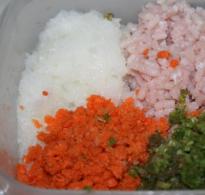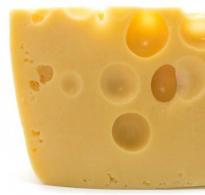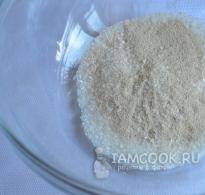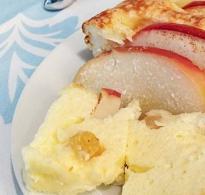How to make Gouda cheese at home. How Industrial Cheese is Made
Or or Use the amount of starter according to the manufacturer's instructions.
Preparation:
1. Heat the milk to 32°C.
2. Add calcium chloride and mix thoroughly.
3. Carefully pour the dry mesophilic starter culture onto the surface of the milk and mix thoroughly after 2-3 minutes.
4. Dissolve the milk-clotting enzyme in 100 ml. water.
5. After exactly 10 minutes, add the milk-clotting enzyme diluted in water, mix gently and thoroughly.
6. After 45 minutes, check the clot for a clean break. When cutting a curd with a knife, the knife should remain clean. If the clot sticks to the knife, wait another 10-15 minutes.
7. Cut the curd into 0.7-1 cm cubes.

8. Leave it alone for 10 minutes.
9. Very carefully we begin to mix the cheese grain, and for 10-12 minutes. raise the temperature to 34°C.

10. Leave it alone for 10 minutes.
11. Pour 4 liters of whey into a separate pan.

12. With continuous stirring, add about 4 liters. water at 56°C until the total temperature reaches 38°C.

13. Leave alone for 10 minutes.
14. Pour the whey into a separate pan, collect the cheese grains in a colander lined with a cloth.
15. Tie the fabric with grain into a ball and hang it in the whey for 30 minutes.

16. Trying not to violate integrity cheese mass, transfer to and press with a load of 6 kg for 30 minutes.

17. We take it out from under the press, change it, turn the cheese head over and press it weighing 10-12 kg for another 1 hour.
18. Turn over, change clothes and press with a load of 12-15 kg for 24 hours.

19. Make the brine. The best way to make brine is from the whey left over from your cheese. In 1 l. dissolve the whey in 250 g of table salt, non-iodized. Heat the brine to 75°C, then cool.
You can make a brine from water. Then for 1 l. boiled water you need to take 250 g of table salt, non-iodized, 2 ml. calcium chloride, 1 tsp. vinegar.
20. We take the cheese out of the press, trim it, trim it if necessary and transfer it to the brine. Sprinkle the protruding part of the head with dry salt. Salt the cheese in brine at the rate of 12 hours per 1 kg. cheese in the refrigerator.

21. Take the cheese out of the brine, wipe it with paper napkins and transfer it to the refrigerator to dry its surface.

22. Turn over every day until a dry crust forms, 3-7 days.
23. After it is formed cheese crust, the cheese will be dry to the touch, transfer it to the refrigerator or cellar for ripening at a temperature of 10-12°C, humidity 85%. It is better to store cheese in the refrigerator in a closed container, it is easier to achieve required humidity. If you have a household vacuum sealer, you can vacuum seal the cheese wheel or coat it with wax. Then there is no need to maintain humidity.
24. We stand for at least 8-10 weeks. We turn over the first few days every day, then at least once a week.

* For pasteurization of milk slowly heat it while stirring to 73°C, maintain this temperature for 20 seconds and cool as quickly as possible.
Gouda is one of the varieties of the world famous Dutch cheese. This product received its name in honor of the Dutch city of Gouda, where it began to be sold before the 19th century. Subsequently, cheese production spread throughout the country.
This semi-hard cheese has a fat content of about 48-51%, a dense plastic structure and a uniform light yellow tint. Young Gouda has a very delicate taste, but with age this cheese acquires brighter flavor notes.
IN classic cheese varieties of Gouda, the formation of small eyes and correct form. Young cheese is aged for about 2-5 months, and to obtain a more crumbly and savory product the ripening period is extended to 1.5 years. At home, it is not recommended to age cheese for more than 6 months.
Equipment
- 8 liter saucepan;
- 3 liter lavsan bag (you can use gauze);
Ingredients
- 8 liters of milk;
- Mesophilic starter (optional):
- 1/8 tsp (0.18 g) Danisco Choozit MM 101 / MM 100 or MA 11
- 1/8 tsp (0.18 g) Hansen CHN-19
- 1/32 tsp (0.06 g) Uglich-4 or Uglich-5A. Optionally - Uglich-P (protection), Uglich-K (acceleration of ripening) - on the tip of the knife.
- 1/2 tsp. (2 ml) liquid rennet;
- 1/2 tsp. (2 ml) calcium chloride solution;
- 20% brine for salting cheese;
- Cheese wax or latex coating.
Yield 10-12% - 0.8-1 kg of cheese.
Recipe
1. Pour milk into a saucepan and heat to 32°C, stirring occasionally to prevent milk from sticking to the bottom. Remove from heat.
2. Sprinkle the mesophilic starter evenly over the surface of the milk. Let sit for 3 minutes to allow the starter to absorb moisture. Then gently stir the entire volume of milk with a slotted spoon for 5 minutes from top to bottom. Cover and let the milk sit for 30 minutes to allow bacteria to grow.
3. Dilute the 10% solution calcium chloride in 50 ml of water, add to milk and mix gently from top to bottom.
4. Dilute liquid rennet in 50 ml of water, add to milk, mix well so that the enzyme is distributed throughout the entire volume of milk.
5. Cover and leave for 45 minutes to form a curd.
6. After 45 minutes, a dense clot should form with the separation of transparent whey. If the curd is unstable and the whey does not separate, let the milk sit for another 5-15 minutes. Cut the curd into cubes with a side of approximately 1.5 cm. Leave for 5 minutes.
7. Next, you need to continuously slowly stir the mass for 5 minutes so that the cheese grain decreases. Let stand again for 5 minutes. The cheese grain should settle to the bottom of the pan and completely separate from the whey. If the cheese grains do not settle, stir for another 5 minutes, then leave for 5 minutes again to allow the grains to settle to the bottom of the pan.
8. Using a measuring cup, remove 0.7 liters of whey (this is approximately 10%) from the pan, carefully so as not to disturb the cheese mass. Instead of whey, pour 0.7 liters of water at a temperature of 65C into the pan so that the entire mass reaches a temperature of 33C. Stir the mixture for 10 minutes, then leave for 5 minutes so that the cheese grain settles.
9. Remove 30% of the whey (2.5 l) from the pan; the cheese grain should be slightly visible from the surface. Pour the same amount (2.5 liters) of water at a temperature of 45C into the pan, stir, check the temperature - it should be 37C.
10. Continuously stir the mixture slowly for 20 minutes. The cheese grain should be the size of a pea. Let the mixture stand for 10 minutes.
11. Pour the whey through the cheese pan until it warms up a bit.
12. Line the mold with gauze or insert a drainage bag, carefully so that there are as few wrinkles as possible. Knead the cheese mass with your hands; it quickly loses whey and thickens.
13. Close the top with the ends of the gauze, avoiding folds if possible. Place the lid on the mold.
14. Place the cheese under the press. Press with a weight of 2 kg for 30 minutes. Remove the cheese from the mold, remove the cheesecloth, and wrap it in cheesecloth again to prevent the folds from cutting into the cheese. Put it back into the mold and put it under the press. Press with a weight of 3 kg for 1 hour. Take out the cheese, re-wrap the cheesecloth and place under a press. Press with a weight of 4 kg for 2 hours.
15. Remove the cheese from the mold and place in 20% brine for 6-8 hours (3-4 hours for every 0.5 kg ready-made cheese). During this time, you need to turn the cheese once in the middle.
16. Remove from the brine, place on a drainage mat and leave the cheese at a temperature of 10-15⁰C for 3-5 days until the crust becomes dry. The cheese must be turned over every day to ensure even ripening and drying.
17. After this, cover the cheese with a latex coating or wax, or seal it in a shrink bag and set it to rest.
18. Before the cheese is ready, it must be kept for 1 month. goat cheese and 2 months for cow. For more aged cheeses, you can leave the cheese for up to 6 months. Don't forget to turn the cheese regularly (1-2 times a week)!
How to prepare 20% brine
Bring 4 liters of water to a boil, dissolve 1 kg of rock salt. Cool to room temperature and strain or carefully drain so that any dirt from the salt (if any) remains at the bottom. Add 5 ml of 6% vinegar, 5 g of dry calcium chloride or 40 ml of 10% calcium chloride solution. The brine can be used several times.
Many centuries ago in the Netherlands, famous for its pastures with lush grass, learned to make from milk a real delicacy. Gouda cheese with golden crust- real cheese king, which is revered all over the world and is prepared, including at home, according to old recipe. In order for the delicacy to turn out truly tasty and tender, you need a lot of milk, as well as patience, because the product matures for about 2 months.
Taste it homemade cheese depends on the quality of milk raw materials, as well as on the period of its maturation. A young gouda at the age of two months is characterized by mild creamy taste and pleasant elasticity. If you keep it in the dark and cool longer, it will become drier, and its taste will acquire sharp, noble notes.

Ingredients
- — 15 l (product yield from this amount of milk is about 2 kg) + -
- Mesophilic starter- 1/2 tsp. + -
- Rennet (liquid)- 3/4 tsp. + -
- Calcium chloride (liquid fraction)- 3/4 tsp. + -
Inventory
- Large saucepan made of high quality stainless steel;
- Long slotted spoon;
- Sharp long knife;
- Cheese molds (2 pieces of 1 kg volume or one larger size);
- Press;
- Special cheese wax.
For the brine
- Cold water – 4 l;
- Rock salt – 1 kg.
Making Gouda cheese at home
- Pour the prepared milk into a clean saucepan and gradually heat it over low heat to 30-32 o C.

- The next step is the addition of dry mesophilic starter, consisting of special lactic bacteria. Spray it evenly over the surface of the heated milk.

- After 3 minutes, armed with a long slotted spoon, mix the contents of the pan with gentle movements from top to bottom. Leave for another half hour so that the bacteria have time to multiply.
- Meanwhile, dilute rennet and calcium chloride in 50 ml cold water(each ingredient separately) and add to milk, stir, cover the container.
- After 1 hour, under the influence of bacteria, enzyme and calcium chloride, the curd, having separated from the whey, floats to the surface, forming a rather dense layer.

- Using a sharp knife, carefully cut it into pieces measuring approximately 1.5 x 1.5 cm, first along the clot, then across it. As a rule, they remain at the bottom large pieces. We chop them too.
- After 5 minutes, when the cheese cubes have settled, you need to take a slotted spoon and gently stir them for the next five minutes.
- Let it sit for another 5 minutes, then stir for another 5 minutes.
- If the cheese grains do not sink to the bottom, you need to stir a little more, and then set aside for 3-5 minutes.
- Now the cheese grains need to be washed. To do this, select 1.5 liters of whey and pour in the same amount of fresh whey instead. hot water(60 o C).
The selected whey can be used for okroshka or used to knead dough for pies.
- Again, carefully stir the contents of the container, thanks to which the cheese grains give up excess moisture, and then let it sit for 5 minutes.

- Next, you need to replace 5 liters of whey with the same amount of water at a temperature of 45 o C.
- Stir for about 20 minutes from top to bottom, then leave for 3-5 minutes and remove all liquid.
Now it's time to fill the plastic molds with cheese. We do this carefully, squeezing it out. In this case, the whey comes out through the holes in the bottom of the molds.

We cover them with special lids on top.
We place the filled molds on a press stand in the form of a shallow tray, covered with a drainage mat, and cover top part structure and place a 4-kilogram weight on top (a 5-liter container not completely filled with water plastic bottle). We press for half an hour.
- Next, remove the load, carefully turn the cheese heads over, and put them under the press again. We increase the load exactly 2 times.
- After another 40 minutes, we repeat the procedure with turning the heads over. We will increase the load to 14 kg and “forget” about the cheese for 6-8 hours.
- Next, taking it out of the mold, salt it in homemade brine(dissolve the salt thoroughly in water and strain) for 24 hours, remembering to turn it over periodically.
- Having taken them out of the brine, remove excess moisture from the heads with a paper towel and leave them to dry for a couple of days at a temperature of 22 o C.
How to make a wax film on homemade gouda
During this time, the cheese heads will be covered with a glossy golden crust. It needs to be covered with a wax film.
- Melt the cheese wax in a water bath and carefully immerse the heads into it.
- When it hardens, we mark the date of production of the gouda on it and send the heads for ripening.
You will have to wait at least 2 months, keeping the future cheese delicacy in the dark at 12-14 o C and humidity not higher than 85%.

Secrets of a successful Guad
No special cheese molds
If the farm does not special molds To prepare Gouda cheese at home, their role can be played by an ordinary colander, which needs to be covered with gauze.
You can cover such an improvised form with an enamel bowl of a suitable diameter.
Lack of abs
In the absence of a special press, it can be replaced with two square ones wooden planks, which are best placed in a wide basin into which excess whey will drain.
To make the cheese harder, leave the load for the third time for 10-12 hours.
Now you know how to make Gouda cheese at home. Everything is simple, and most importantly – divinely tasty and very healthy.
Bon appetit!
Gouda- Dutch hard cheese, one of the most popular cheeses in the world. Gouda and its derivatives account for more than half of the world's cheese consumption. Traditional Gouda is made from whole cow's milk fat content 3.7-3.9%, however, there are also lighter dietary versions with fat content starting from 20%. There are varieties of Gouda made from goat's and sheep's milk, which usually take longer to mature. Gouda is often complemented various additives and spices, smoked, which makes the range of this cheese even more diverse. For example, Leiden the cheese is made according to the Gouda recipe with the addition of cumin and cloves. In the original, Gouda is a cheese with a dense consistency and a very small number of small round eyes. Cheese dough has a nice yellow, which, as it ripens, acquires richer dark caramel shades, and small crispy crystals appear in the body of the cheese, just like in Parmesan, formed by the amino acid tyrosine.One of the main technological stages preparation of Gouda is washing the cheese grain: replacing part of the whey hot water, which reduces its acidity and at the same time gently heats the cheese grain, resulting in a smooth and elastic cheese texture. Traditionally, Gouda is ripened covered in wax, which makes the requirements for the ripening chamber more lenient: you just need to maintain a temperature of 11-13ºC.
Ingredients
8 l.
whole milk
not UHT
1/4 tsp.
non-gas-forming mesophilic culture powder
1/2 tsp.
liquid rennet (veal)
dissolve in 50ml water temperature 30-35ºС
or rennet in another form, in dosage, according to the directions on the package
use animal rennet for this recipe
1 ½ tsp (8 ml.)
calcium chloride, solution 10%
dissolve in 50ml water at room temperature
or follow the dosage specified by the manufacturer drug on the package
maximum application dose - 2 g of dry calcium chloride per 10 liters of milk
1 tbsp.
[for Leiden cheese] caraway
1/2 tsp.
[for Leiden cheese] carnation
1 tbsp.
[for mustard cheese] mustard seeds
150 ml
[for Leiden and mustard cheese] filtered water
1/8 tsp
[For blue cheese] Penicillium roqueforti
Salt bath
500 g.
medium sea salt
not iodized
2 l.
boiled water
1/2 tbsp.
calcium chloride, solution 33%
1/2 tsp.
white vinegar
After cooking you will receive: 1 cheese weighing 700 g.
Equipment
10 l.
pot
enameled or stainless steel, for heating milk
pot
for water bath , large enough to fit the main saucepan
with max. load from 7 kg
cheese press
food thermometer
long knife
for slicing curds
skimmer
wooden or plastic
[optional] set of mini measuring spoons
[optional] set of measuring cups
for 1 kg., ∅ 16cm
cheese pressing mold
1emmicro-perforated, cylindrical, wide, with a follower lid (you can also use a ball shape)
drainage fabric
gauze, muslin or other drainage material
sterile disposable gloves
cheese coating
wax alloy, latex or maturation bag
for 3 l.
brine container
Sterilize all equipment before making cheese. You can wash it and pour boiling water over it
Gouda cheese preparation schedule (from start to finish of preparation)
First day:
- 3 hours to prepare the cheese mass (active phase)
- 6-8 hours for pressing (passive phase)
- 8 hours for salting (overnight, passive phase)
Subsequent days:
- 1-3 days for drying the crust (passive phase)
- 1-24 months to mature
Step-by-step recipe for making Gouda and Leiden cheeses
- [for Leiden cheese or mustard cheese] Pour water over cumin and clove/mustard seeds and boil for 15 minutes. low heat. After this, separate the grains and the liquid in which they were cooked. Dry the grains (for Leiden cheese, remove the cloves from the cumin, they are only needed to flavor the liquid), and cool the liquid. Mix the cooled aromatic liquid with milk.
- Slowly heat the milk in a water bath to 30°C, stirring constantly so that the temperature is distributed evenly. When the milk is hot, pour calcium chloride diluted in water into it.
- Add the starter to the pan with milk: sprinkle the powder on the surface of the milk, let it stand and absorb moisture for 3-5 minutes, then mix thoroughly, distributing the starter throughout the entire volume of milk.
- Cover the pan with a lid and leave for 45 minutes to allow the starter to activate in the milk. Try to maintain the temperature at 30°C.
- Slowly pour in the diluted enzyme, constantly stirring the milk in a top-down motion to distribute it as much as possible throughout the entire volume of milk.
- Cover the pan with a lid and leave for 45 minutes for the milk to curdle.
[optional] To accurately determine the required clotting time and obtain a clot desired consistency and calculate the coagulation time using the formula K = F * M (multiplier = 3, F - flocculation time in minutes). After the calculation, leave the clot alone for the remaining number of minutes. - Swipe . If the clot is not dense enough, leave for another 10-15 minutes.
- Cut the curd into equal small cubes with sides of 1-1.5 cm. Cut vertically using a long knife, leave for 5 minutes to firm up the edges, and then cut horizontally. Be careful: at first the curd will be tender and loose; it can easily be accidentally split into too small pieces.
- Start stirring the cheese grain for 5 minutes, then leave it alone for another 5 minutes: the grain will settle to the bottom of the pan.
- Meanwhile, prepare 2 liters of hot filtered water at 60 °C - we will need it for the procedure of washing the cheese grain.
- Drain 2 cups of whey from the pan and, stirring constantly, pour in 2 cups of hot water instead. It is necessary that the temperature of the cheese grain rises to 33 °C. If two cups are not enough, pour more until the desired temperature. Leave the grain alone for another 10 minutes.
- When the grain has once again settled to the bottom of the pan, remove the whey so that it covers the surface of the cheese grain by about 2 cm.
- Begin to slowly pour hot water into the pan, one mug at a time, constantly stirring the grain. The goal is to reach a temperature of 37° C.
- Once the temperature is reached, continue stirring the grain for another 20 minutes until the grain feels springy to the touch.
- Stop stirring and let the curds settle to the bottom of the pan over the next 10 minutes.
- Drain the whey so that the remaining part covers the cheese grain by 3-5 centimeters.
- [optional, for Leiden/mustard cheese] Pour cumin/mustard into the cheese grain and stir so that the grains are evenly distributed throughout.
- Wear sterile gloves. Gather the grain into one layer under the whey layer and carefully move it into the mold. Try to carry out this procedure without removing the grains from under the whey layer. This way, the closed texture of the future cheese will be ensured: there should be no air voids between the cheese grains. Simply transferring the cheese grains into the mold will result in mechanical eyes and an incorrect cheese pattern.
- Leave the mold with the cheese mixture in the whey for 15 minutes for self-pressing.
- Close the mold with a lid-follower and place under the press. Press with a 4.5 kg load for the first 30 minutes.
- Remove the cheese from the press and from the mold, turn it over and re-wrap it in drainage cloth.
- Place under a press, load 7 kg, time - 6-8 hours.
- While the cheese is being pressed, prepare the brine (see ingredients for proportions and composition) and cool it to a temperature of 10-13° C.
- Once pressing is complete, remove the cheese from the mold and drainage cloth, weigh it and place it in the prepared brine, sprinkling the top with a layer of salt. Salting time is an hour for every 100 g of cheese (i.e. in our case, you will get a head of ~800 g and will salt for 8 hours). Halfway through the salting period, the cheese must be turned over in the brine so that it salts evenly.
- Remove the cheese from the brine and blot off any excess moisture with a paper towel. Place the cheese on a drainage mat where it will dry room temperature within 1-3 days. Turn the cheese at least 2 times a day so that the crust dries evenly.
- When the cheese crust has become dry, move it to a ripening chamber with a temperature of 11-13 °C and 85% humidity for 1 week. Remember to turn the cheese daily. If mold appears, wipe it off with a piece of cloth soaked in light brine or vinegar.
- Cover the cheese with wax, latex, or vacuum seal it in a ripening bag. In this form, the cheese will ripen for 1 month at a temperature of 11-13 °C. In the case of Gouda, it is difficult to go too far with the ripening period - 5-year-old cheese has simply amazing taste.
Blue Gouda
 Photo kennyscheese.com
Photo kennyscheese.com
Typically, blue cheeses have a soft, open texture that provides good conditions for the development of mold P.roqueforti. However, there is a variation of Gouda with blue mold, which has completely unique taste characteristics. Even though the cheese has a dense texture, punctures in its body will allow mold to develop.
How to do:
- Along with the starter, add 1/8 tsp to the milk. mold Penicillium roqueforti, mix thoroughly.
- After salting, pierce the head of cheese with a thin sterile knitting needle from the top and bottom at about 2/3 of the height of the head in several places. Make punctures every 2-2.5 cm.
- There is no need to cover this cheese with wax; you need to leave the natural crust. The humidity in the ripening chamber must be maintained at 85-90%, temperature - 11-13° C.
Happy cheese making!
Gouda cheese originates from the Netherlands, but is now produced in many countries. By the way, in Russia it is successfully replaced by the well-known Kostroma cheese, which in properties and composition is practically no different from Gouda.
Gouda cheese is similar to Edam cheese, but it is firmer and produced in larger heads.
Gouda - light cheese with a soft creamy taste. The more mature the cheese, the more its character changes. It acquires a stronger aroma and becomes drier. A special variety of this cheese is “Dutch Master,” which matures for almost a year.
The rind of Gouda cheese is thin, dry, smooth, and light gray to gray-green in color.
The cheese dough is white to yellowish in color, matte, not waxy.
The structure of Gouda cheese at home is hard and elastic. Round or oval eyes, evenly distributed throughout the cheese dough.
The taste and aroma are not spicy, turning into spicy, but not sour.
How to make Gouda cheese
To prepare Gouda cheese with 50% fat content use whole milk 3.75-3.9% fat content and high hygienic quality.
Short-term high-temperature pasteurization at 72°C for 15-20 s is used as heat treatment. In some regions, flash heating to 75°C is used. Cool the milk to 31°C.
Add 0.02% (in the form of a 35% solution), as well as 0.005% sodium nitrate to inhibit the development of gas-forming bacteria.
In winter or early spring, add 1-2 ml of annatto or carotene per 100 liters of milk. To produce cheeses with a more intense color, use 20-25 ml of annatto per 100 liters of milk.
As a starter, 0.5-1% (on average 0.8%) of the starter culture is added at a temperature of 31°C. Lactococcus lactissubsp is used at different enterprises. lactis, L. Lactis subsp. lactis biovar, diacetylactis and Leuconostocmesenteroides subsp. cremoris.
Rennet is added in an amount sufficient to obtain a curd ready for cutting within 25-30 minutes; usually add 0.8 - 1.2 g rennet CHY-MAX ExtraPowder for 100 liters of milk. At a temperature of 28-30°C and acidity of 0.19-0.20%.
The clot is cut within 10-15 minutes into cubes 0.5-1.5 cm in size using knives with steel blades or a harp.
Knead to dry and prevent the cheese grain from settling.
Knead for 20-30 minutes, then leave; after the cheese grain settles, 30% of the whey is removed.
Add water (at a temperature not higher than 80°C), heating the cheese mass to 36-38°C (possibly up to 32-40°C).
Stir continuously for 15-20 minutes while adding hot water, and then for another 20-30 minutes.
The cheese grain is left to settle to the bottom of the bath, and then the resulting layer is pressed using steel plates.
The whey is removed after compacting the cheese mass.
Molding is carried out at a pH of 5.85-6.05, using wooden or plastic molds consisting of 2 parts.
The cheese mass is cut in the bath. The cheeses are wrapped in a napkin, placed in a mold, covered with a lid on top and transferred under a press.
You can buy a mold for Gouda cheese in the online store with delivery by Russian post or courier service.
The cheeses are pressed for 5-8 hours. During pressing, they are turned over and given the desired shape (sharp edges are smoothed out).
Increase the load by increasing the pressure from 95 to 195 kPa. The pH value of the pressed cheese mass is 5.1-5.2, the acidity of the whey released during the pressing process is 0.35-0.40%.
The cheese is immersed in brine at a temperature of 15°C for 3-5 days. Brine concentration 20% and pH 4.8. The salt content in cheese should be 1.5-1.8%, pH - 5.15-5.25.
You need to keep in mind that it takes longer than a month for salt to penetrate into the central part of the cheese.
Gouda cheese ripening occurs at a temperature of 15°C for 4-6 weeks, after 2 weeks. The pH is 5.2-5.3.
Mature cheese is stored at 10°C for 6-12 months. (after 8 weeks the pH is 5.3-5.5).






